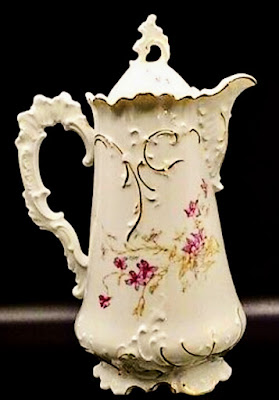The ambassador, having mentioned in the morning that his birthplace was Furstenberg, the Queen had recalled to mind a service of china never used, and for nine years put away and forgotten by every one but herself, which had been manufactured there, and was decorated with painted scenes of the town and its vicinity. She knew exactly where it was and how It looked, and by her order it had been produced and used at dinner—surely a very pretty attention from a royal hostess, as well as something of a feat of memory in a royal housekeeper. – An antique Furstenberg china hot chocolate pot. Furstenberg china is the second oldest porcelain company in Germany and its antique pieces are highly collectible.
Victoria as a Housekeeper
England’s Queen Demands Good Service, but Pays Employees Liberally
The sound business capacity and marvelous memory for details which serve Queen Victoria so well in her greater office of sovereign, do not fail to render her successful also in her lesser one of housekeeper. She is the mistress of palaces, castles and country houses, and, although the actual daily housekeeping is, of course, done by deputy, the royal head of the establishment remains ever in a very real sense the mistress. She perceives immediately anything amiss, and perceives also the remedy. She is a kind but also an exacting mistress, and as she pays well, and never fails to consider a reasonable excuse, quite properly demands good service and tolerates no shirking.
A recent little volume upon her private life relates several entertaining household anecdotes of the royal lady's ways. She has, it seems, a dislike of cold meat, which she never eats, but etiquette demands that at luncheon a side table shall stand ready, provided with cold fowl and a cold joint, no matter what daintier hot food the dining table may offer. Like every good housekeeper, the Queen knows and remembers her valuable household possessions, and is fully aware of their individual merit and the places where they ought to be kept. She does not know them all, for they number thousands, but hundreds of them she does know, and elaborate catalogues are kept of the rest—furniture, bric-a-brac, china, glass, silver, draperies, and other furnishings—by her order, and in large leather bounds books provided in accordance with her ideas. Only a small proportion of her many hundred articles for table service are actually in ordinary use, and she is in the habit of using but three of her many services of plate and china at Windsor Castle.
But once, after a talk with the German ambassador, who was visiting her, the members of the Queen’s household were surprised on coming to the table to behold strange china set before them, each plate adorned with landscape paintings. It soon appeared that, the ambassador, having mentioned in the morning that his birthplace was Furstenberg, the Queen had recalled to mind a service of china never used, and for nine years put away and forgotten by every one but herself, which had been manufactured there, and was decorated with painted scenes of the town and its vicinity. She knew exactly where it was and how It looked, and by her order it had been produced and used at dinner—surely a very pretty attention from a royal hostess, as well as something of a feat of memory in a royal housekeeper. –Placer Herald, 1898
Etiquette Enthusiast, Maura J Graber, is the Site Editor for the Etiquipedia© Etiquette Encyclopedia

No comments:
Post a Comment
Note: Only a member of this blog may post a comment.